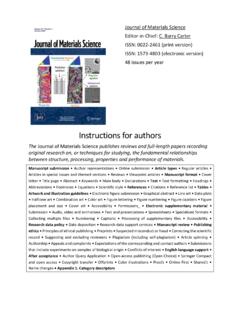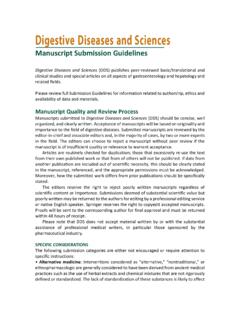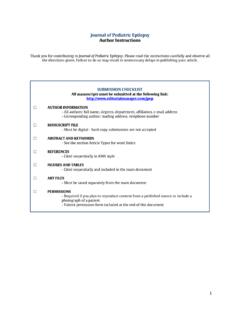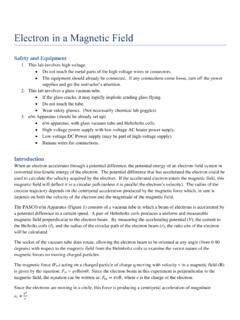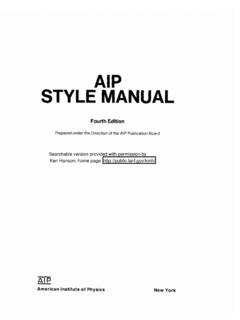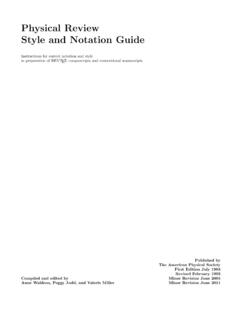Transcription of Instructions for authors
1 Journal of Materials Science Editor-in-Chief: C. Barry Carter ISSN: 0022-2461 (print version) ISSN: 1573-4803 (electronic version) Journal no. 10853 Instructions for authors The Journal of Materials Science publishes reviews and full-length papers recording original research on, or techniques for studying, the fundamental relationships between structure, processing, properties and performance of materials. Manuscript submission Author representations Online submission Article types Regular articles Articles in special issues and themed sections Reviews Viewpoint articles Manuscript format Cover letter Title page Abstract Keywords Main body Declarations Text Text formatting Headings Abbreviations Footnotes Equations Scientific style References Citations Reference list Tables Artwork and illustration guidelines Electronic figure submission Graphical abstract Line art Data plots Halftone art Combination art Color art Figure lettering Figure numbering Figure captions Figure placement and size Cover art Accessibility Permissions Electronic supplementary material Submission Audio.
2 Video and animations Text and presentations Spreadsheets Specialized formats Collecting multiple files Numbering Captions Processing of supplementary files Accessibility Research data policy Data deposition Research data support services Manuscript review Publishing ethics Principles of ethical publishing Preprints Suspected misconduct or fraud Correcting the scientific record Suggesting and excluding reviewers Plagiarism (including self-plagiarism) Article spinning Authorship Appeals and complaints Expectations of the corresponding and contact authors Submissions that include experiments on samples of biological origin Conflicts of interest English language support After acceptance Author Query Application Open-access publishing (Open Choice) Springer Compact and open access Copyright transfer Offprints Color illustrations Proofs Online First SharedIt Name changes Appendix 1. Category descriptors Journal of Materials Science Instructions for authors August 2021 2 Manuscript submission Author representations Submission of a manuscript implies: that the work described has not been previously published in a peer-reviewed publication in any format, including in languages other than English but excluding theses; that it is not under consideration for publication anywhere else; that its publication has been approved by all co- authors , if any, as well as by the responsible authorities tacitly or explicitly at the institute where the work has been carried out.
3 The publisher will not be held legally responsible should there be any claims for compensation. Online submission authors must submit their manuscripts online via the Journal of Materials Science Editorial Manager website at: All correspondence related to the submission will come through Editorial Manager. Correspondence will be sent from in Springer s Journal Editorial Office (JEO) or a journal editor and contain a unique reference number for the manuscript. The reference number will begin with JMSC-D- followed by a two-digit year and a five-digit submission number. A message will be sent to the corresponding author acknowledging receipt of the submission. Co- authors will be sent similar notifications. Article types Regular articles Regular articles report significant original research on, or techniques for studying, the fundamental relationships between structure, processing, properties and performance of materials. Typical topics include, but are not limited to, metals, ceramics, glasses, polymers, electrical and electronic materials, composite materials, fibers, nanostructured materials and materials for application in the life sciences.
4 The Journal s article category descriptors are listed in Appendix 1. Papers are selected for high quality and broad interest to the materials science community. Some papers that are not accepted for publication, before or after the external peer-review process, will receive an option to be transferred to other Springer journals through Springer s Transfer Desk service. The median typeset length for a regular research article published in the Journal in 2020 was 13 pages, equivalent to about 3000 4000 words. Articles in special issues and themed sections Special issues and sections are collections of themed articles, sometimes arising from a conference, symposium or other notable event. Only full papers of the same standard as regular articles will be considered for publication in special issues. Articles submitted to the Journal for inclusion in special issues are processed in the same manner as regular articles but will typically involve a Guest Editor in addition to the normal Editorial Board.
5 Reviews Review articles are intended to be topical, comprehensive summaries of the state-of-the-art in a particular aspect of materials science. Review articles must be substantial, authoritative and critical reviews of published results of high current interest on recent active topics (with key developments within the past 4 to 5 years) in any area of materials science, broadly defined. The reviews should have a high potential for a broad impact. A critical assessment and analysis of the literature should be included, rather than a simple collation of published information. The review should provide a balanced look at the field, and the work of the authors should not be overemphasized. Possible future developments, insights about remaining challenges and future directions should also be presented and discussed. The authors should be recognized experts in the field. Journal of Materials Science Instructions for authors August 2021 3 The cover letter and introduction should explicitly state the community s need for the review, citing the differences between this review and others that are already published; have explicit inclusion/exclusion criteria; and be appropriately illustrated.
6 The cover letter should additionally include a brief description of the authors qualifications and expertise in the area of the review s topic. The manuscript and illustration guidelines are the same as regular articles. Evidence of reprint permissions for illustrations must be included with the revised manuscript along with the attribution statement. See the Permissions section for details. A review article should be around 8000 words (excluding captions and references) with at least 100 references. The median typeset length for a review article published in the Journal in 2018 2020 was 24 pages. The median number of references in these articles was 142. Review articles should have the word review in their title. Prospective authors of reviews should contact the Editor-in-Chief before preparing their articles. Viewpoint articles Viewpoint articles, introduced in 2016, are short personal perspectives on a topical area of general interest to the materials science community.
7 authors of Viewpoint articles are invited by the Editor-in-Chief. Suggestions for Viewpoint articles may be directed to the Editor-in-Chief. Manuscript format Cover letter All submissions must include a cover letter, which is seen only by the editorial team, that includes: A confirmation of author representations that: the work described has not been published before; it is not under consideration for publication anywhere else; and publication has been approved by all co- authors and the responsible authorities at the institute(s) where the work has been carried out. A statement of the novelty and significance of the work and the relevance to the aims and scope of the Journal of Materials Science. This statement should not be a duplicate of the submission s abstract. Names, affiliations and email addresses of at least three suitable referees, together with a brief statement of why they are qualified to evaluate the manuscript. authors are welcome to list non-preferred reviewers.
8 Any preference for category descriptor. The editor will make the final decision for article categorization. If the submission has previously been considered for publication by any other journal, the authors are encouraged, but not required, to include in their cover letter the manuscript s previous submission history and response to referees comments. This information may be sent to the manuscript s referees. In the case of an invited resubmission to the Journal of Materials Science, the manuscript identification code and, if known, the name of the editor who handled the initial submission should also be included. Journal of Materials Science Instructions for authors August 2021 4 Title page The title page should include: The name(s) of the author(s), with symbols to link each name with that author s institutional affiliation and an asterisk to denote the corresponding author(s); A concise and informative title; and The e-mail address of the corresponding authors Titles should be succinct, objective, interesting and grammatically correct.
9 The use of abbreviations in titles is discouraged. These abbreviations can appear in the abstract and keywords to ensure the article is automatically indexed properly. Please see the Journal s 2016 editorial on this topic for more suggestions on crafting an appropriate title. Titles of review articles should include the word review . The author list should include only those who have made significant scientific contributions to the manuscript. These contributions must include conception and planning of the work that led to the manuscript or acquisition, analysis and interpretation of the data, or both; drafting or critical revision of the manuscript for important intellectual content, or both; and approval of the final submitted version of the manuscript. Others who have contributed to the work should be noted in the Acknowledgements. Author names will be published exactly as they appear on the accepted submission. The corresponding or contact author is required to ensure that names of all authors are present and correctly spelled and that all authors addresses and affiliations are current.
10 Changes to the author list between initial submission and revision must be accompanied by an explanatory statement in the cover letter for the revision and a completed Change in Authorship Request form, which will be sent by the Journal Editorial Office. These changes will be accepted at the discretion of the Editor and may lead to rejection of the manuscript. Changes of authorship or in the order of authors are not accepted after acceptance of a manuscript. More detail on authorship is included in the section on publishing ethics. All of Springer Nature s imprints have a trans-inclusive name change policy that enables silent and retroactive name changes. Abstract The abstract should be 150 to 250 words. The content should state the main purposes and research questions of the study, the methods used, the main results and the key conclusions. Structured abstracts should not be used. authors are encouraged to submit a graphical abstract. This should be included after the references.
